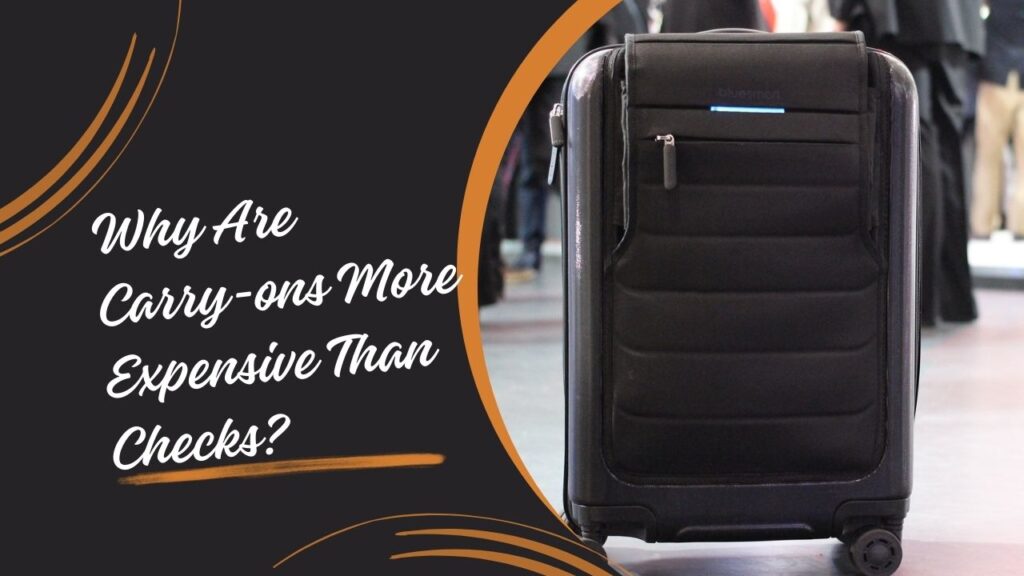Why Are Carry-ons More Expensive Than Checks? Carry-ons are often pricier because they help airlines streamline boarding and optimize cabin space, whereas checked bags require more ground handling.
Over the last decade, air travel has transformed, and so have the expenses associated with it. One major change is the way airlines handle baggage fees.
Surprisingly, on some flights, carry-on luggage can cost more than checked bags. This trend may seem counterintuitive at first, especially since checked luggage requires additional handling, staff, and equipment.
However, there are multiple economic and operational factors behind why airlines make carry-ons more expensive. In this article, we’ll dive into why this pricing strategy exists and how it impacts travelers.
The Role of Airline Economics
Maximizing Revenue Streams
Airlines operate in a highly competitive market. Many carriers, particularly low-cost and budget airlines, keep ticket prices low to attract more customers.
However, low ticket prices alone aren’t enough to sustain profitability. Baggage fees have become a crucial source of revenue, enabling airlines to keep fares competitive while generating additional income through ancillary fees.
For instance, low-cost carriers like Spirit Airlines and Frontier Airlines rely heavily on fees for carry-ons, checked bags, seat selection, and even onboard refreshments.
This allows them to advertise lower base fares, which is highly attractive to cost-conscious travelers. [Why Are Carry-ons More Expensive Than Checks?]
With add-ons like carry-on fees, they can make up the difference without directly raising the base price of a ticket.
Charging more for carry-ons also allows airlines to balance their revenue model. Unlike full-service airlines, low-cost carriers typically operate on thinner profit margins, so every added fee helps cover operational costs.
By strategically setting higher fees on popular services like carry-ons, they ensure they meet their financial targets without risking a drop in customer interest due to higher ticket prices.
Operational Efficiency
Carry-on fees aren’t only about revenue—they also serve to streamline flight operations. When passengers bring fewer items on board, boarding and deplaning times decrease significantly.
For airlines, this reduction in ground time is crucial, as it allows planes to spend more time in the air and less time at the gate, enhancing overall efficiency.
Fast turnaround times are particularly important for airlines with tight schedules and short-haul flights. [Why Are Carry-ons More Expensive Than Checks?]
Every minute saved on the ground is an opportunity for airlines to improve their schedule, reduce delays, and ultimately increase the number of flights they can operate in a day.
Charging a premium for carry-ons incentivizes passengers to check their bags instead, reducing cabin congestion and minimizing the number of bags that need to be accommodated in overhead bins.
Overhead bin space is another reason for charging more on carry-ons. Aircraft cabins have limited space, and once the bins are full, the boarding process slows as flight attendants find alternative storage solutions.
By pricing carry-ons higher, airlines can control the number of carry-ons and maintain an orderly boarding process. [Why Are Carry-ons More Expensive Than Checks?]
This leads to fewer instances of passengers having to gate-check their carry-ons, which can be disruptive to schedules.
Passenger Convenience and Demand
Preference for Carry-Ons
Many travelers prefer carry-ons over checked bags because of the convenience factor. With a carry-on, passengers can skip the baggage claim, reducing overall travel time.
This is especially valuable for business travelers or anyone on a tight schedule. Additionally, having immediate access to personal items during the flight offers a sense of security that checked baggage doesn’t provide.
Passengers know that their belongings are with them and won’t risk being misplaced or delayed in transit. [Why Are Carry-ons More Expensive Than Checks?]
This convenience has led to a higher demand for carry-on space. In response, airlines have realized that passengers are willing to pay extra for the ability to carry their bags on board.
The increased demand allows airlines to set carry-on fees higher, knowing that a significant number of passengers will still opt to bring their bags on board despite the additional cost. [Why Are Carry-ons More Expensive Than Checks?]
Perceived Value
Another factor driving higher carry-on fees is the perceived value associated with carry-ons. When given the choice, many passengers see a carry-on as a premium option.
It allows them more control over their belongings, reduces the risk of lost luggage, and offers flexibility when it comes to packing. [Why Are Carry-ons More Expensive Than Checks?]
This perception of carry-ons as a valuable service means that airlines can justify a higher fee. For travelers, the ability to access their luggage right after landing often outweighs the cost.
Airlines leverage this psychological aspect, knowing that many passengers prioritize carry-ons and will choose to pay more for the added peace of mind.
Cost Implications for Airlines
Ground Handling vs. In-Flight Space
Checked bags require more resources in terms of ground handling, including the need for baggage handlers, loading equipment, and storage.
Despite this, carry-ons can be more valuable due to the limited space available in the cabin. Overhead bin space is a precious resource, and airlines need to manage it carefully.
By charging more for carry-ons, airlines effectively control the demand for overhead storage and ensure that the bins aren’t overfilled. [Why Are Carry-ons More Expensive Than Checks?]
In cases where passengers bring oversized carry-ons, they may have to gate-check their bags, which is often a time-consuming process.
Managing carry-on demand through fees helps airlines avoid these situations and ensures that the boarding process remains smooth and efficient.
For the airline, the cost of in-flight storage management is offset by the higher carry-on fee, making it financially sustainable to prioritize cabin efficiency over ground handling.
Turnaround Time
Time is one of the most valuable resources for airlines. The faster an airline can board passengers, secure carry-ons, and prepare the plane for takeoff, the more flights it can schedule in a day. [Why Are Carry-ons More Expensive Than Checks?]
By reducing the number of carry-ons, airlines can shorten boarding times and minimize delays caused by passengers struggling to find overhead bin space.
In a competitive industry where schedule adherence is a top priority, even small reductions in turnaround time make a significant impact.
Higher carry-on fees push more passengers to check bags, leaving more space for those who genuinely need or prefer to keep their luggage in the cabin.
This optimization helps airlines stick to their schedules and maintain high efficiency. [Why Are Carry-ons More Expensive Than Checks?]
Fee Variability and Strategies
Different Policies by Airline
Not all airlines follow the same fee structure. Full-service airlines, like Delta and United, often include one or two checked bags as part of their ticket price for certain fares or loyalty tiers.
This approach is less common with budget airlines, which rely more heavily on add-on fees. [Why Are Carry-ons More Expensive Than Checks?]
Low-cost carriers like Spirit and Frontier tend to charge for every additional service, including carry-ons, while traditional carriers may include more services upfront but charge higher ticket prices.
This variability gives travelers options when choosing an airline, though it can lead to confusion over what’s included in each fare.
Understanding these different policies allows passengers to make better decisions based on their travel preferences and budget. [Why Are Carry-ons More Expensive Than Checks?]
Dynamic Pricing Models
Another factor contributing to high carry-on fees is dynamic pricing. Similar to how ticket prices fluctuate based on demand, some airlines adjust baggage fees during peak travel periods.
For instance, around holidays or summer vacation periods, baggage fees may increase as airlines anticipate higher demand. [Why Are Carry-ons More Expensive Than Checks?]
This model allows airlines to capitalize on the increased volume of travelers who are willing to pay extra for the convenience of carry-ons during busy seasons.
Dynamic pricing models also incentivize travelers to plan ahead and book their luggage options early. In many cases, purchasing baggage options at the time of booking is cheaper than waiting until the day of travel.
Consumer Tips for Managing Baggage Costs
Choosing the Right Fare
Many airlines offer fare bundles that include carry-ons, checked bags, and even seat selection. For travelers with multiple pieces of luggage, bundled fares can provide substantial savings.
For example, American Airlines and Delta offer bundled fares that include one or two checked bags, making them a better option for passengers with more luggage.
Travel Light Strategies
Packing light and making use of a personal item, such as a backpack or tote bag, can also help travelers avoid baggage fees.
Personal items typically fly for free, even on low-cost airlines, as long as they fit under the seat. [Why Are Carry-ons More Expensive Than Checks?]
By packing smart and sticking to essentials, travelers can save money while still keeping their belongings close.
Frequent Flyer Programs and Credit Card Perks
Frequent flyer programs often come with benefits like free carry-ons, priority boarding, and waived baggage fees.
Some credit cards also offer annual travel credits or include baggage fee waivers as part of their rewards. [Why Are Carry-ons More Expensive Than Checks?]
These perks can make a big difference for regular travelers, allowing them to save on baggage costs while enjoying extra benefits.
Final Verdict
The trend of higher fees for carry-ons than checked bags is part of a broader shift in the airline industry toward unbundled pricing and optimized operational efficiency.
Airlines use these fees to streamline boarding, ensure efficient use of cabin space, and maintain tight schedules. [Why Are Carry-ons More Expensive Than Checks?]
While it may seem counterintuitive, charging more for carry-ons benefits both airlines and passengers by reducing overhead congestion and speeding up flight turnaround times.
For passengers, understanding these fees helps in making informed choices. The extra convenience and control offered by carry-ons can justify the cost for some, while others may prefer to check their bags to save money. [Why Are Carry-ons More Expensive Than Checks?]
By weighing these options and exploring fare bundles or loyalty programs, travelers can make cost-effective decisions that align with their travel priorities.
See Also: Why Are JOOLA Ping Pong Balls So Expensive?
FAQs
Why do some airlines charge more for carry-ons than checked bags?
Airlines charge more for carry-ons to control cabin space, encourage efficient boarding, and maximize revenue, particularly among low-cost carriers.
Which airlines have the highest carry-on fees?
Low-cost airlines like Spirit and Frontier often have the highest carry-on fees, as they rely heavily on ancillary charges to supplement low base fares.
Can I avoid carry-on fees by checking my bag?
Yes, in many cases, checking a bag can be cheaper than bringing a carry-on, especially if you’re flexible with baggage claim wait times. [Why Are Carry-ons More Expensive Than Checks?]
Do international flights follow the same pricing trend?
Not always. Many international carriers include a free checked bag, though carry-on restrictions may still apply based on the airline’s policies.
How can frequent travelers save on baggage fees?
Joining frequent flyer programs, using travel credit cards, or booking bundled fare options can help travelers save on baggage fees. [Why Are Carry-ons More Expensive Than Checks?]
Conclusion: Why Are Carry-ons More Expensive Than Checks?
As airlines continue to refine their pricing strategies, baggage fees are likely to remain a key focus.
For travelers, understanding the rationale behind these fees is essential for budgeting and making informed travel decisions.
Whether you prioritize convenience or cost savings, knowing your options can make your journey smoother and more affordable.

Hello, I’m Ashlyn Fleming from Sedona, Arizona. After finishing my Master’s, I noticed rising prices on everything I buy for my family. Curious about why, I started a blog to share my findings with friends and family.
